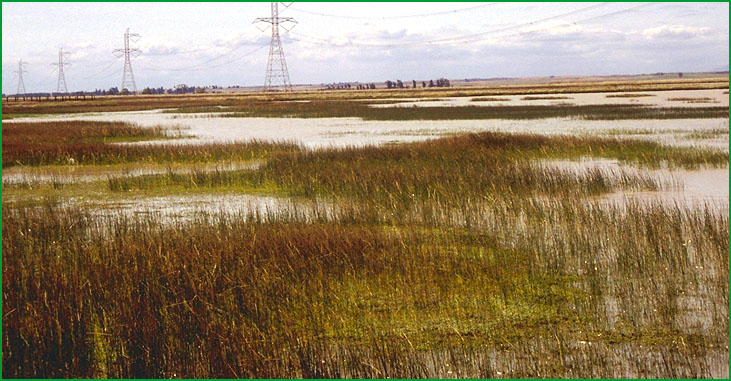 | Sodic Claypan Terraces |
Jepson Prairie area southeast of Vacaville Glen Stanisewski |
http://www.fs.fed.us/r5/projects/ecoregions/262aj.htm
This subsection is on a late Quaternary alluvial plain on the lower west side of Sacramento Valley. The climate is hot and subhumid. MLRA 17e.
Lithology and Stratigraphy. This subsection contains late Quaternary alluvium from volcanic, sedimentary, and metamorphic rock sources.
Geomorphology. This subsection is mainly nearly level to gently sloping late Pleistocene and recent alluvial fans from the southern end of the northern California Coast Ranges. The subsection elevation range is from about 20 to about 120 feet. Fluvial erosion and deposition are the main geomorphic processes.
Soils. The soils are mostly Typic Palexeralfs, Typic and Aquic Natrixeralfs, Pelloxererts and Chromoxererts, and some Typic, Aquic, and Mollic Haploxeralfs. Xerorthents, Xerochrepts, and Aeric Haplaquepts on recent alluvium. The soils are mostly moderately well and somewhat poorly drained, with some well and poorly drained. Sodium accumulates in some soils with claypans. Soil temperature regimes are thermic, and soil moisture regimes are mostly xeric and some aquic.
Vegetation. The predominant natural plant communities are Needlegrass grasslands, and Northern claypan vernal pools are common.
Characteristic series by lifeform include:
Grasslands: California annual grassland series, Purple needlegrass series.
Vernal pools: Northern claypan vernal pools.
Climate. The mean annual precipitation is about 16 to 20 inches. It is practically all rain. Mean annual temperature is about 59¯ to 62¯ F. The mean freeze-free period is about 250 to 275 days.
Surface Water. Streams in this subsection drain to the Sacramento River. All but the larger streams are generally dry during the summer. There are no lakes, but there is temporary ponding in vernal pools on the older alluvial fans.
